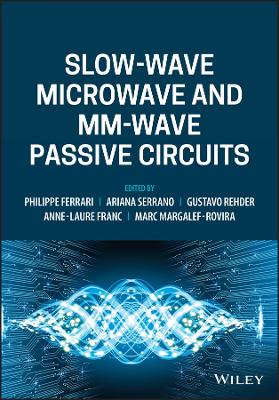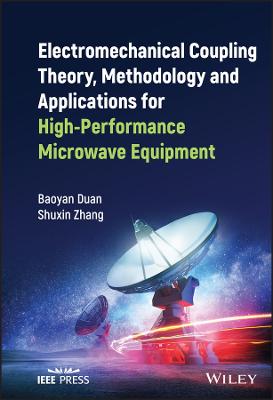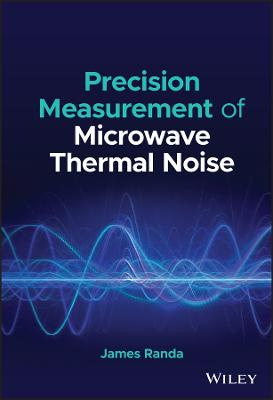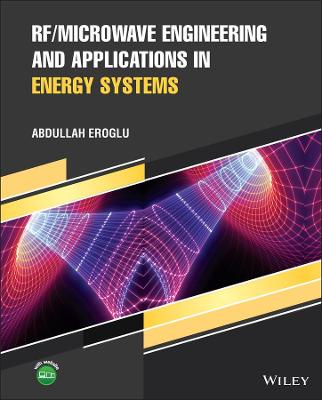High Power Microwave Sources and Technologies Using Metamaterials
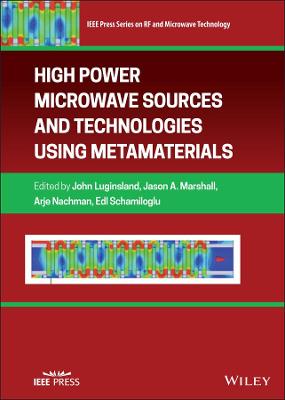 -15%
portes grátis
-15%
portes grátis
High Power Microwave Sources and Technologies Using Metamaterials
Marshall, Jason A.; Luginsland, John W.; Nachman, Arje; Schamiloglu, Edl
John Wiley & Sons Inc
01/2022
304
Dura
Inglês
9781119384441
15 a 20 dias
722
Descrição não disponível.
Editor Biographies xi
List of Contributors xiii
Foreword xvii
Preface xix
1 Introduction and Overview of the Book 1
Rebecca Seviour
1.1 Introduction 1
1.2 Electromagnetic Materials 2
1.3 Effective-Media Theory 4
1.4 History of Effective Materials 4
1.4.1 Artificial Dielectrics 4
1.4.2 Artificial Magnetic Media 5
1.5 Double Negative Media 7
1.5.1 DNG Realization 9
1.6 Backward Wave Propagation 9
1.7 Dispersion 10
1.8 Parameter Retrieval 12
1.9 Loss 13
1.10 Summary 14
References 14
2 Multitransmission Line Model for Slow Wave Structures Interacting with Electron Beams and Multimode Synchronization 17
Ahmed F. Abdelshafy, Mohamed A.K. Othman, Alexander Figotin, and Filippo Capolino
2.1 Introduction 17
2.2 Transmission Lines: A Preview 18
2.2.1 Multiple Transmission Line Model 18
2.3 Modeling of Waveguide Propagation Using the Equivalent Transmission Line Model 20
2.3.1 Propagation in Uniform Waveguides 21
2.3.2 Propagation in Periodic Waveguides 22
2.3.3 Floquet's Theorem 24
2.4 Pierce Theory and the Importance of Transmission Line Model 25
2.5 Generalized Pierce Model for Multimodal Slow Wave Structures 28
2.5.1 Multitransmission Line Formulation Without Electron Beam: "Cold SWS" 28
2.5.2 Multitransmission Line Interacting with an Electron Beam: "Hot SWS" 30
2.6 Periodic Slow-Wave Structure and Transfer Matrix Method 32
2.7 Multiple Degenerate Modes Synchronized with the Electron Beam 34
2.7.1 Multimode Degeneracy Condition 34
2.7.2 Degenerate Band Edge (DBE) 34
2.7.3 Super Synchronization 35
2.7.4 Complex Dispersion Characteristics of a Periodic MTL Interacting with an Electron Beam 38
2.8 Giant Amplification Associated to Multimode Synchronization 39
2.9 Low Starting Electron Beam Current in Multimode Synchronization-Based Oscillators 42
2.10 SWS Made by Dual Nonidentical Coupled Transmission Lines Inside a Waveguide 46
2.10.1 Dispersion Engineering Using Dual Nonidentical Pair of TLs 47
2.10.2 BWO Design Using Butterfly Structure 49
2.11 Three-Eigenmode Super Synchronization: Applications in Amplifiers 50
2.12 Summary 53
References 54
3 Generalized Pierce Model from the Lagrangian 57
Alexander Figotin and Guillermo Reyes
3.1 Introduction 57
3.2 Main Results 59
3.2.1 Lagrangian Structure of the Standard Pierce Model 59
3.2.2 Multiple Transmission Lines 60
3.2.3 The Amplification Mechanism and Negative Potential Energy 60
3.2.4 Beam Instability and Degenerate Beam Lagrangian 61
3.2.5 Full Characterization of the Existence of an Amplifying Regime 61
3.2.6 Energy Conservation and Fluxes 62
3.2.7 Negative Potential Energy and General Gain Media 62
3.3 Pierce's Model 63
3.4 Lagrangian Formulation of Pierce's Model 65
3.4.1 The Lagrangian 65
3.4.2 Generalization to Multiple Transmission Lines 67
3.5 Hamiltonian Structure of the MTLB System 68
3.5.1 Hamiltonian Forms for Quadratic Lagrangian Densities 68
3.5.2 The MTLB System 70
3.6 The Beam as a Source of Amplification: The Role of Instability 71
3.6.1 Space Charge Wave Dynamics: Eigenmodes and Stability Issues 71
3.7 Amplification for the Homogeneous Case 74
3.7.1 Asymptotic Behavior of the Amplification Factor as ? ? 0 and as ? ? ? 77
3.8 Energy Conservation and Transfer 77
3.8.1 Energy Exchange Between Subsystems 78
3.9 The Pierce Model Revisited 80
3.10 Mathematical Subjects 82
3.10.1 Energy Conservation via Noether's Theorem 82
3.10.2 Energy Exchange Between Subsystems 83
3.11 Summary 84
References 84
4 Dispersion Engineering for Slow-Wave Structure Design 87
Ushe Chipengo, Niru K. Nahar, John L. Volakis, Alan D. R. Phelps, and Adrian W. Cross
4.1 Introduction 87
4.2 Metamaterial Complementary Split Ring Resonator-Based Slow-Wave Structure 88
4.2.1 Complementary Split Ring Resonator Plate-Loaded Metamaterial Waveguide: Design 89
4.2.2 Complementary Split Ring Resonator Plate-Loaded Metamaterial Waveguide: Fabrication and Cold Test 92
4.3 Broadside Coupled Split Ring Resonator-Based Metamaterial Slow-Wave Structure 94
4.3.1 Broadside-Coupled Split Ring-Loaded Metamaterial Waveguide: Design 94
4.3.2 Broadside-Coupled Split Ring-Loaded Metamaterial Waveguide: Fabrication and Cold Test 97
4.4 Iris Ring-Loaded Waveguide Slow-Wave Structure with a Degenerate Band Edge 97
4.4.1 Iris Loaded-DBE Slow-Wave Structure: Design 100
4.4.2 Iris-Loaded DBE Slow-Wave Structure: Fabrication and Cold Test 102
4.5 Two-Dimensional Periodic Surface Lattice-Based Slow-Wave Structure 102
4.5.1 Two-Dimensional Periodic Surface Lattice Slow-Wave Structure: Design 104
4.5.2 Two-Dimensional Periodic Surface Lattice Slow-Wave Structure: Fabrication and Cold Test 106
4.6 Curved Ring-Bar Slow-Wave Structure for High-Power Traveling Wave Tube Amplifiers 107
4.6.1 Curved Ring-Bar Slow-Wave Structure: Design 108
4.6.2 Curved Ring-Bar Slow-Wave Structure: Fabrication and Cold Testing 112
4.7 A Corrugated Cylindrical Slow-Wave Structure with Cavity Recessions and Metallic Ring Insertions 114
4.7.1 Design of a Corrugated Cylindrical Slow-Wave Structure with Cavity Recessions and Metallic Ring Insertions 116
4.7.2 Fabrication and Cold testing of a Homogeneous, Corrugated Cylindrical Slow-Wave Structure with Cavity Recessions and Metallic Ring Insertions 119
4.7.3 Inhomogeneous SWS design based on the Corrugated Cylindrical SWS with Cavity Recessions and Metallic Ring Insertions: Fabrication and Cold Testing 121
4.8 Summary 123
References 123
5 Perturbation Analysis of Maxwell's Equations 127
Robert Lipton, Anthony Polizzi, and Lokendra Thakur
5.1 Introduction 127
5.2 Gain from Floating Interaction Structures 129
5.2.1 Anisotropic Effective Properties and the Dispersion Relation 130
5.2.2 A Pierce-Like Approach to Dispersion 133
5.3 Gain from Grounded Interaction Structures 133
5.3.1 Model Description 134
5.3.2 Physics of Waveguides and Maxwell's Equations 134
5.3.3 Perturbation Series for Leading Order Dispersive Behavior 137
5.3.4 Leading Order Theory of Gain for Hybrid Space Charge Modes for a Corrugated SWS with Beam 138
5.3.4.1 Hybrid Modes in Beam 140
5.3.4.2 Impedance Condition 141
5.3.4.3 Cold Structure 141
5.3.4.4 Pierce Theory 142
5.4 Electrodynamics Inside a Finite-Length TWT: Transmission Line Model 142
5.4.1 Solution of the Transmission Line Approximation 145
5.4.2 Discussion of Results 145
5.5 Corrugated Oscillators 148
5.5.1 Oscillator Geometry 148
5.5.2 Solutions of Maxwell's Equations in the Oscillator 149
5.5.3 Perturbation Expansions 151
5.5.4 Leading Order Theory: The Subwavelength Limit of the Asymptotic Expansions 151
5.5.5 Dispersion Relation for ?? 152
5.6 Summary 154
References 154
6 Similarity of the Properties of Conventional Periodic Structures with Metamaterial Slow Wave Structures 157
Sabahattin Yurt, Edl Schamiloglu, Robert Lipton, Anthony Polizzi, and Lokendra Thakur
6.1 Introduction 157
6.2 Motivation 157
6.3 Observations 159
6.3.1 Appearance of Negative Dispersion for Low-Order Waves 159
6.3.2 Evolution of Wave Dispersion in Uniform Periodic Systems with Increasing Corrugation Depth 160
6.3.2.1 SWS with Sinusoidal Corrugations 161
6.3.2.2 SWS with Rectangular Corrugations 164
6.4 Analysis of Metamaterial Surfaces from Perfectly Conducting Subwavelength Corrugations 168
6.4.1 Approach 169
6.4.2 Model Description 169
6.4.2.1 Physics of Waveguides and Maxwell's Equations 170
6.4.2.2 Two-Scale Asymptotic Expansions 172
6.4.2.3 Leading Order Theory: The Subwavelength Limit of the Asymptotic Expansions 172
6.4.2.4 Nonlocal Surface Impedance Formulation for Time Harmonic Fields 173
6.4.2.5 Effective Surface Impedance for Hybrid Modes in Circular Waveguides 174
6.4.3 Metamaterials and Corrugations as Microresonators 175
6.4.4 Controlling Negative Dispersion and Power Flow with Corrugation Depth 177
6.4.5 Summary 182
References 182
7 Group Theory Approach for Designing MTM Structures for High-Power Microwave Devices 185
Hamide Seidfaraji, Christos Christodoulou, and Edl Schamiloglu
7.1 Group Theory Background 185
7.1.1 Symmetry Elements 186
7.1.2 Symmetry Point Group 187
7.1.3 Character Table 187
7.2 MTM Analysis Using Group Theory 188
7.2.1 Split Ring Resonator Behavior Analysis Using Group Theory 189
7.2.1.1 Principles of Group Theory 189
7.2.1.2 Basis Current in SSRs 191
7.3 Inverse Problem-Solving Using Group Theory 194
7.4 Designing an Ideal MTM 195
7.5 Proposed New Structure Using Group Theory 195
7.6 Design of Isotropic Negative Index Material 197
7.7 Multibeam Backward Wave Oscillator Design using MTM and Group Theory 199
7.7.1 Introduction and Motivation 199
7.7.2 Metamaterial Design 200
7.7.3 Theory of Electron Beam Interaction with Metamaterial Waveguide 203
7.7.4 Hot Test Particle-in-Cell Simulations 204
7.8 Particle-in-Cell Simulations 204
7.9 Efficiency 207
7.10 Summary 208
References 209
8 Time-Domain Behavior of the Evolution of Electromagnetic Fields in Metamaterial Structures 211
Mark Gilmore, Tyler Wynkoop, and Mohamed Aziz Hmaidi
8.1 Introduction 211
8.2 Experimental Observations 212
8.2.1 Bandstop Filter (BSF) System 215
8.2.2 Bandpass Filter (BPF) System 217
8.3 Numerical Simulations 224
8.3.1 Bandstop System (BSF) 225
8.3.2 Bandpass Filter System (BPF) 226
8.3.3 Experiment-Model Comparison 227
8.4 Attempts at a Linear Circuit Model 229
References 230
9 Metamaterial Survivability in the High-Power Microwave Environment 233
Rebecca Seviour
9.1 Introduction 233
9.2 Split Ring Resonator Loss 234
9.3 CSRR Loss 237
9.4 Artificial Material Loss 239
9.5 Disorder 241
9.6 Summary 242
References 244
10 Experimental Hot Test of Beam/Wave Interactions with Metamaterial Slow Wave Structures 245
Michael A. Shapiro, Jason S. Hummelt, Xueying Lu, and Richard J. Temkin
10.1 First-Stage Experiment at MIT 246
10.1.1 Metamaterial Structure 246
10.1.2 Experimental Results 247
10.1.3 Summary of First-Stage Experiments 251
10.2 Second-Stage Experiment at MIT 251
10.3 Metamaterial Structure with Reverse Symmetry 252
10.4 Experimental Results on High-Power Generation 255
10.5 Frequency Measurement in Hot Test 257
10.6 Steering Coil Control 262
10.7 University of New Mexico/University of California Irvine Collaboration on a High Power Metamaterial Cherenkov Oscillator 264
10.8 Summary 264
References 265
11 Conclusions and Future Directions 267
John Luginsland, Jason A. Marshall, Arje Nachman, and Edl Schamiloglu
References 268
Index 271
List of Contributors xiii
Foreword xvii
Preface xix
1 Introduction and Overview of the Book 1
Rebecca Seviour
1.1 Introduction 1
1.2 Electromagnetic Materials 2
1.3 Effective-Media Theory 4
1.4 History of Effective Materials 4
1.4.1 Artificial Dielectrics 4
1.4.2 Artificial Magnetic Media 5
1.5 Double Negative Media 7
1.5.1 DNG Realization 9
1.6 Backward Wave Propagation 9
1.7 Dispersion 10
1.8 Parameter Retrieval 12
1.9 Loss 13
1.10 Summary 14
References 14
2 Multitransmission Line Model for Slow Wave Structures Interacting with Electron Beams and Multimode Synchronization 17
Ahmed F. Abdelshafy, Mohamed A.K. Othman, Alexander Figotin, and Filippo Capolino
2.1 Introduction 17
2.2 Transmission Lines: A Preview 18
2.2.1 Multiple Transmission Line Model 18
2.3 Modeling of Waveguide Propagation Using the Equivalent Transmission Line Model 20
2.3.1 Propagation in Uniform Waveguides 21
2.3.2 Propagation in Periodic Waveguides 22
2.3.3 Floquet's Theorem 24
2.4 Pierce Theory and the Importance of Transmission Line Model 25
2.5 Generalized Pierce Model for Multimodal Slow Wave Structures 28
2.5.1 Multitransmission Line Formulation Without Electron Beam: "Cold SWS" 28
2.5.2 Multitransmission Line Interacting with an Electron Beam: "Hot SWS" 30
2.6 Periodic Slow-Wave Structure and Transfer Matrix Method 32
2.7 Multiple Degenerate Modes Synchronized with the Electron Beam 34
2.7.1 Multimode Degeneracy Condition 34
2.7.2 Degenerate Band Edge (DBE) 34
2.7.3 Super Synchronization 35
2.7.4 Complex Dispersion Characteristics of a Periodic MTL Interacting with an Electron Beam 38
2.8 Giant Amplification Associated to Multimode Synchronization 39
2.9 Low Starting Electron Beam Current in Multimode Synchronization-Based Oscillators 42
2.10 SWS Made by Dual Nonidentical Coupled Transmission Lines Inside a Waveguide 46
2.10.1 Dispersion Engineering Using Dual Nonidentical Pair of TLs 47
2.10.2 BWO Design Using Butterfly Structure 49
2.11 Three-Eigenmode Super Synchronization: Applications in Amplifiers 50
2.12 Summary 53
References 54
3 Generalized Pierce Model from the Lagrangian 57
Alexander Figotin and Guillermo Reyes
3.1 Introduction 57
3.2 Main Results 59
3.2.1 Lagrangian Structure of the Standard Pierce Model 59
3.2.2 Multiple Transmission Lines 60
3.2.3 The Amplification Mechanism and Negative Potential Energy 60
3.2.4 Beam Instability and Degenerate Beam Lagrangian 61
3.2.5 Full Characterization of the Existence of an Amplifying Regime 61
3.2.6 Energy Conservation and Fluxes 62
3.2.7 Negative Potential Energy and General Gain Media 62
3.3 Pierce's Model 63
3.4 Lagrangian Formulation of Pierce's Model 65
3.4.1 The Lagrangian 65
3.4.2 Generalization to Multiple Transmission Lines 67
3.5 Hamiltonian Structure of the MTLB System 68
3.5.1 Hamiltonian Forms for Quadratic Lagrangian Densities 68
3.5.2 The MTLB System 70
3.6 The Beam as a Source of Amplification: The Role of Instability 71
3.6.1 Space Charge Wave Dynamics: Eigenmodes and Stability Issues 71
3.7 Amplification for the Homogeneous Case 74
3.7.1 Asymptotic Behavior of the Amplification Factor as ? ? 0 and as ? ? ? 77
3.8 Energy Conservation and Transfer 77
3.8.1 Energy Exchange Between Subsystems 78
3.9 The Pierce Model Revisited 80
3.10 Mathematical Subjects 82
3.10.1 Energy Conservation via Noether's Theorem 82
3.10.2 Energy Exchange Between Subsystems 83
3.11 Summary 84
References 84
4 Dispersion Engineering for Slow-Wave Structure Design 87
Ushe Chipengo, Niru K. Nahar, John L. Volakis, Alan D. R. Phelps, and Adrian W. Cross
4.1 Introduction 87
4.2 Metamaterial Complementary Split Ring Resonator-Based Slow-Wave Structure 88
4.2.1 Complementary Split Ring Resonator Plate-Loaded Metamaterial Waveguide: Design 89
4.2.2 Complementary Split Ring Resonator Plate-Loaded Metamaterial Waveguide: Fabrication and Cold Test 92
4.3 Broadside Coupled Split Ring Resonator-Based Metamaterial Slow-Wave Structure 94
4.3.1 Broadside-Coupled Split Ring-Loaded Metamaterial Waveguide: Design 94
4.3.2 Broadside-Coupled Split Ring-Loaded Metamaterial Waveguide: Fabrication and Cold Test 97
4.4 Iris Ring-Loaded Waveguide Slow-Wave Structure with a Degenerate Band Edge 97
4.4.1 Iris Loaded-DBE Slow-Wave Structure: Design 100
4.4.2 Iris-Loaded DBE Slow-Wave Structure: Fabrication and Cold Test 102
4.5 Two-Dimensional Periodic Surface Lattice-Based Slow-Wave Structure 102
4.5.1 Two-Dimensional Periodic Surface Lattice Slow-Wave Structure: Design 104
4.5.2 Two-Dimensional Periodic Surface Lattice Slow-Wave Structure: Fabrication and Cold Test 106
4.6 Curved Ring-Bar Slow-Wave Structure for High-Power Traveling Wave Tube Amplifiers 107
4.6.1 Curved Ring-Bar Slow-Wave Structure: Design 108
4.6.2 Curved Ring-Bar Slow-Wave Structure: Fabrication and Cold Testing 112
4.7 A Corrugated Cylindrical Slow-Wave Structure with Cavity Recessions and Metallic Ring Insertions 114
4.7.1 Design of a Corrugated Cylindrical Slow-Wave Structure with Cavity Recessions and Metallic Ring Insertions 116
4.7.2 Fabrication and Cold testing of a Homogeneous, Corrugated Cylindrical Slow-Wave Structure with Cavity Recessions and Metallic Ring Insertions 119
4.7.3 Inhomogeneous SWS design based on the Corrugated Cylindrical SWS with Cavity Recessions and Metallic Ring Insertions: Fabrication and Cold Testing 121
4.8 Summary 123
References 123
5 Perturbation Analysis of Maxwell's Equations 127
Robert Lipton, Anthony Polizzi, and Lokendra Thakur
5.1 Introduction 127
5.2 Gain from Floating Interaction Structures 129
5.2.1 Anisotropic Effective Properties and the Dispersion Relation 130
5.2.2 A Pierce-Like Approach to Dispersion 133
5.3 Gain from Grounded Interaction Structures 133
5.3.1 Model Description 134
5.3.2 Physics of Waveguides and Maxwell's Equations 134
5.3.3 Perturbation Series for Leading Order Dispersive Behavior 137
5.3.4 Leading Order Theory of Gain for Hybrid Space Charge Modes for a Corrugated SWS with Beam 138
5.3.4.1 Hybrid Modes in Beam 140
5.3.4.2 Impedance Condition 141
5.3.4.3 Cold Structure 141
5.3.4.4 Pierce Theory 142
5.4 Electrodynamics Inside a Finite-Length TWT: Transmission Line Model 142
5.4.1 Solution of the Transmission Line Approximation 145
5.4.2 Discussion of Results 145
5.5 Corrugated Oscillators 148
5.5.1 Oscillator Geometry 148
5.5.2 Solutions of Maxwell's Equations in the Oscillator 149
5.5.3 Perturbation Expansions 151
5.5.4 Leading Order Theory: The Subwavelength Limit of the Asymptotic Expansions 151
5.5.5 Dispersion Relation for ?? 152
5.6 Summary 154
References 154
6 Similarity of the Properties of Conventional Periodic Structures with Metamaterial Slow Wave Structures 157
Sabahattin Yurt, Edl Schamiloglu, Robert Lipton, Anthony Polizzi, and Lokendra Thakur
6.1 Introduction 157
6.2 Motivation 157
6.3 Observations 159
6.3.1 Appearance of Negative Dispersion for Low-Order Waves 159
6.3.2 Evolution of Wave Dispersion in Uniform Periodic Systems with Increasing Corrugation Depth 160
6.3.2.1 SWS with Sinusoidal Corrugations 161
6.3.2.2 SWS with Rectangular Corrugations 164
6.4 Analysis of Metamaterial Surfaces from Perfectly Conducting Subwavelength Corrugations 168
6.4.1 Approach 169
6.4.2 Model Description 169
6.4.2.1 Physics of Waveguides and Maxwell's Equations 170
6.4.2.2 Two-Scale Asymptotic Expansions 172
6.4.2.3 Leading Order Theory: The Subwavelength Limit of the Asymptotic Expansions 172
6.4.2.4 Nonlocal Surface Impedance Formulation for Time Harmonic Fields 173
6.4.2.5 Effective Surface Impedance for Hybrid Modes in Circular Waveguides 174
6.4.3 Metamaterials and Corrugations as Microresonators 175
6.4.4 Controlling Negative Dispersion and Power Flow with Corrugation Depth 177
6.4.5 Summary 182
References 182
7 Group Theory Approach for Designing MTM Structures for High-Power Microwave Devices 185
Hamide Seidfaraji, Christos Christodoulou, and Edl Schamiloglu
7.1 Group Theory Background 185
7.1.1 Symmetry Elements 186
7.1.2 Symmetry Point Group 187
7.1.3 Character Table 187
7.2 MTM Analysis Using Group Theory 188
7.2.1 Split Ring Resonator Behavior Analysis Using Group Theory 189
7.2.1.1 Principles of Group Theory 189
7.2.1.2 Basis Current in SSRs 191
7.3 Inverse Problem-Solving Using Group Theory 194
7.4 Designing an Ideal MTM 195
7.5 Proposed New Structure Using Group Theory 195
7.6 Design of Isotropic Negative Index Material 197
7.7 Multibeam Backward Wave Oscillator Design using MTM and Group Theory 199
7.7.1 Introduction and Motivation 199
7.7.2 Metamaterial Design 200
7.7.3 Theory of Electron Beam Interaction with Metamaterial Waveguide 203
7.7.4 Hot Test Particle-in-Cell Simulations 204
7.8 Particle-in-Cell Simulations 204
7.9 Efficiency 207
7.10 Summary 208
References 209
8 Time-Domain Behavior of the Evolution of Electromagnetic Fields in Metamaterial Structures 211
Mark Gilmore, Tyler Wynkoop, and Mohamed Aziz Hmaidi
8.1 Introduction 211
8.2 Experimental Observations 212
8.2.1 Bandstop Filter (BSF) System 215
8.2.2 Bandpass Filter (BPF) System 217
8.3 Numerical Simulations 224
8.3.1 Bandstop System (BSF) 225
8.3.2 Bandpass Filter System (BPF) 226
8.3.3 Experiment-Model Comparison 227
8.4 Attempts at a Linear Circuit Model 229
References 230
9 Metamaterial Survivability in the High-Power Microwave Environment 233
Rebecca Seviour
9.1 Introduction 233
9.2 Split Ring Resonator Loss 234
9.3 CSRR Loss 237
9.4 Artificial Material Loss 239
9.5 Disorder 241
9.6 Summary 242
References 244
10 Experimental Hot Test of Beam/Wave Interactions with Metamaterial Slow Wave Structures 245
Michael A. Shapiro, Jason S. Hummelt, Xueying Lu, and Richard J. Temkin
10.1 First-Stage Experiment at MIT 246
10.1.1 Metamaterial Structure 246
10.1.2 Experimental Results 247
10.1.3 Summary of First-Stage Experiments 251
10.2 Second-Stage Experiment at MIT 251
10.3 Metamaterial Structure with Reverse Symmetry 252
10.4 Experimental Results on High-Power Generation 255
10.5 Frequency Measurement in Hot Test 257
10.6 Steering Coil Control 262
10.7 University of New Mexico/University of California Irvine Collaboration on a High Power Metamaterial Cherenkov Oscillator 264
10.8 Summary 264
References 265
11 Conclusions and Future Directions 267
John Luginsland, Jason A. Marshall, Arje Nachman, and Edl Schamiloglu
References 268
Index 271
Este título pertence ao(s) assunto(s) indicados(s). Para ver outros títulos clique no assunto desejado.
high power microwave technologies; high power microwave sources and metamaterials; metamaterial high power microwave sources; slow wave structures; dispersion engineering; slow wave structure design; slow wave structure theory
Editor Biographies xi
List of Contributors xiii
Foreword xvii
Preface xix
1 Introduction and Overview of the Book 1
Rebecca Seviour
1.1 Introduction 1
1.2 Electromagnetic Materials 2
1.3 Effective-Media Theory 4
1.4 History of Effective Materials 4
1.4.1 Artificial Dielectrics 4
1.4.2 Artificial Magnetic Media 5
1.5 Double Negative Media 7
1.5.1 DNG Realization 9
1.6 Backward Wave Propagation 9
1.7 Dispersion 10
1.8 Parameter Retrieval 12
1.9 Loss 13
1.10 Summary 14
References 14
2 Multitransmission Line Model for Slow Wave Structures Interacting with Electron Beams and Multimode Synchronization 17
Ahmed F. Abdelshafy, Mohamed A.K. Othman, Alexander Figotin, and Filippo Capolino
2.1 Introduction 17
2.2 Transmission Lines: A Preview 18
2.2.1 Multiple Transmission Line Model 18
2.3 Modeling of Waveguide Propagation Using the Equivalent Transmission Line Model 20
2.3.1 Propagation in Uniform Waveguides 21
2.3.2 Propagation in Periodic Waveguides 22
2.3.3 Floquet's Theorem 24
2.4 Pierce Theory and the Importance of Transmission Line Model 25
2.5 Generalized Pierce Model for Multimodal Slow Wave Structures 28
2.5.1 Multitransmission Line Formulation Without Electron Beam: "Cold SWS" 28
2.5.2 Multitransmission Line Interacting with an Electron Beam: "Hot SWS" 30
2.6 Periodic Slow-Wave Structure and Transfer Matrix Method 32
2.7 Multiple Degenerate Modes Synchronized with the Electron Beam 34
2.7.1 Multimode Degeneracy Condition 34
2.7.2 Degenerate Band Edge (DBE) 34
2.7.3 Super Synchronization 35
2.7.4 Complex Dispersion Characteristics of a Periodic MTL Interacting with an Electron Beam 38
2.8 Giant Amplification Associated to Multimode Synchronization 39
2.9 Low Starting Electron Beam Current in Multimode Synchronization-Based Oscillators 42
2.10 SWS Made by Dual Nonidentical Coupled Transmission Lines Inside a Waveguide 46
2.10.1 Dispersion Engineering Using Dual Nonidentical Pair of TLs 47
2.10.2 BWO Design Using Butterfly Structure 49
2.11 Three-Eigenmode Super Synchronization: Applications in Amplifiers 50
2.12 Summary 53
References 54
3 Generalized Pierce Model from the Lagrangian 57
Alexander Figotin and Guillermo Reyes
3.1 Introduction 57
3.2 Main Results 59
3.2.1 Lagrangian Structure of the Standard Pierce Model 59
3.2.2 Multiple Transmission Lines 60
3.2.3 The Amplification Mechanism and Negative Potential Energy 60
3.2.4 Beam Instability and Degenerate Beam Lagrangian 61
3.2.5 Full Characterization of the Existence of an Amplifying Regime 61
3.2.6 Energy Conservation and Fluxes 62
3.2.7 Negative Potential Energy and General Gain Media 62
3.3 Pierce's Model 63
3.4 Lagrangian Formulation of Pierce's Model 65
3.4.1 The Lagrangian 65
3.4.2 Generalization to Multiple Transmission Lines 67
3.5 Hamiltonian Structure of the MTLB System 68
3.5.1 Hamiltonian Forms for Quadratic Lagrangian Densities 68
3.5.2 The MTLB System 70
3.6 The Beam as a Source of Amplification: The Role of Instability 71
3.6.1 Space Charge Wave Dynamics: Eigenmodes and Stability Issues 71
3.7 Amplification for the Homogeneous Case 74
3.7.1 Asymptotic Behavior of the Amplification Factor as ? ? 0 and as ? ? ? 77
3.8 Energy Conservation and Transfer 77
3.8.1 Energy Exchange Between Subsystems 78
3.9 The Pierce Model Revisited 80
3.10 Mathematical Subjects 82
3.10.1 Energy Conservation via Noether's Theorem 82
3.10.2 Energy Exchange Between Subsystems 83
3.11 Summary 84
References 84
4 Dispersion Engineering for Slow-Wave Structure Design 87
Ushe Chipengo, Niru K. Nahar, John L. Volakis, Alan D. R. Phelps, and Adrian W. Cross
4.1 Introduction 87
4.2 Metamaterial Complementary Split Ring Resonator-Based Slow-Wave Structure 88
4.2.1 Complementary Split Ring Resonator Plate-Loaded Metamaterial Waveguide: Design 89
4.2.2 Complementary Split Ring Resonator Plate-Loaded Metamaterial Waveguide: Fabrication and Cold Test 92
4.3 Broadside Coupled Split Ring Resonator-Based Metamaterial Slow-Wave Structure 94
4.3.1 Broadside-Coupled Split Ring-Loaded Metamaterial Waveguide: Design 94
4.3.2 Broadside-Coupled Split Ring-Loaded Metamaterial Waveguide: Fabrication and Cold Test 97
4.4 Iris Ring-Loaded Waveguide Slow-Wave Structure with a Degenerate Band Edge 97
4.4.1 Iris Loaded-DBE Slow-Wave Structure: Design 100
4.4.2 Iris-Loaded DBE Slow-Wave Structure: Fabrication and Cold Test 102
4.5 Two-Dimensional Periodic Surface Lattice-Based Slow-Wave Structure 102
4.5.1 Two-Dimensional Periodic Surface Lattice Slow-Wave Structure: Design 104
4.5.2 Two-Dimensional Periodic Surface Lattice Slow-Wave Structure: Fabrication and Cold Test 106
4.6 Curved Ring-Bar Slow-Wave Structure for High-Power Traveling Wave Tube Amplifiers 107
4.6.1 Curved Ring-Bar Slow-Wave Structure: Design 108
4.6.2 Curved Ring-Bar Slow-Wave Structure: Fabrication and Cold Testing 112
4.7 A Corrugated Cylindrical Slow-Wave Structure with Cavity Recessions and Metallic Ring Insertions 114
4.7.1 Design of a Corrugated Cylindrical Slow-Wave Structure with Cavity Recessions and Metallic Ring Insertions 116
4.7.2 Fabrication and Cold testing of a Homogeneous, Corrugated Cylindrical Slow-Wave Structure with Cavity Recessions and Metallic Ring Insertions 119
4.7.3 Inhomogeneous SWS design based on the Corrugated Cylindrical SWS with Cavity Recessions and Metallic Ring Insertions: Fabrication and Cold Testing 121
4.8 Summary 123
References 123
5 Perturbation Analysis of Maxwell's Equations 127
Robert Lipton, Anthony Polizzi, and Lokendra Thakur
5.1 Introduction 127
5.2 Gain from Floating Interaction Structures 129
5.2.1 Anisotropic Effective Properties and the Dispersion Relation 130
5.2.2 A Pierce-Like Approach to Dispersion 133
5.3 Gain from Grounded Interaction Structures 133
5.3.1 Model Description 134
5.3.2 Physics of Waveguides and Maxwell's Equations 134
5.3.3 Perturbation Series for Leading Order Dispersive Behavior 137
5.3.4 Leading Order Theory of Gain for Hybrid Space Charge Modes for a Corrugated SWS with Beam 138
5.3.4.1 Hybrid Modes in Beam 140
5.3.4.2 Impedance Condition 141
5.3.4.3 Cold Structure 141
5.3.4.4 Pierce Theory 142
5.4 Electrodynamics Inside a Finite-Length TWT: Transmission Line Model 142
5.4.1 Solution of the Transmission Line Approximation 145
5.4.2 Discussion of Results 145
5.5 Corrugated Oscillators 148
5.5.1 Oscillator Geometry 148
5.5.2 Solutions of Maxwell's Equations in the Oscillator 149
5.5.3 Perturbation Expansions 151
5.5.4 Leading Order Theory: The Subwavelength Limit of the Asymptotic Expansions 151
5.5.5 Dispersion Relation for ?? 152
5.6 Summary 154
References 154
6 Similarity of the Properties of Conventional Periodic Structures with Metamaterial Slow Wave Structures 157
Sabahattin Yurt, Edl Schamiloglu, Robert Lipton, Anthony Polizzi, and Lokendra Thakur
6.1 Introduction 157
6.2 Motivation 157
6.3 Observations 159
6.3.1 Appearance of Negative Dispersion for Low-Order Waves 159
6.3.2 Evolution of Wave Dispersion in Uniform Periodic Systems with Increasing Corrugation Depth 160
6.3.2.1 SWS with Sinusoidal Corrugations 161
6.3.2.2 SWS with Rectangular Corrugations 164
6.4 Analysis of Metamaterial Surfaces from Perfectly Conducting Subwavelength Corrugations 168
6.4.1 Approach 169
6.4.2 Model Description 169
6.4.2.1 Physics of Waveguides and Maxwell's Equations 170
6.4.2.2 Two-Scale Asymptotic Expansions 172
6.4.2.3 Leading Order Theory: The Subwavelength Limit of the Asymptotic Expansions 172
6.4.2.4 Nonlocal Surface Impedance Formulation for Time Harmonic Fields 173
6.4.2.5 Effective Surface Impedance for Hybrid Modes in Circular Waveguides 174
6.4.3 Metamaterials and Corrugations as Microresonators 175
6.4.4 Controlling Negative Dispersion and Power Flow with Corrugation Depth 177
6.4.5 Summary 182
References 182
7 Group Theory Approach for Designing MTM Structures for High-Power Microwave Devices 185
Hamide Seidfaraji, Christos Christodoulou, and Edl Schamiloglu
7.1 Group Theory Background 185
7.1.1 Symmetry Elements 186
7.1.2 Symmetry Point Group 187
7.1.3 Character Table 187
7.2 MTM Analysis Using Group Theory 188
7.2.1 Split Ring Resonator Behavior Analysis Using Group Theory 189
7.2.1.1 Principles of Group Theory 189
7.2.1.2 Basis Current in SSRs 191
7.3 Inverse Problem-Solving Using Group Theory 194
7.4 Designing an Ideal MTM 195
7.5 Proposed New Structure Using Group Theory 195
7.6 Design of Isotropic Negative Index Material 197
7.7 Multibeam Backward Wave Oscillator Design using MTM and Group Theory 199
7.7.1 Introduction and Motivation 199
7.7.2 Metamaterial Design 200
7.7.3 Theory of Electron Beam Interaction with Metamaterial Waveguide 203
7.7.4 Hot Test Particle-in-Cell Simulations 204
7.8 Particle-in-Cell Simulations 204
7.9 Efficiency 207
7.10 Summary 208
References 209
8 Time-Domain Behavior of the Evolution of Electromagnetic Fields in Metamaterial Structures 211
Mark Gilmore, Tyler Wynkoop, and Mohamed Aziz Hmaidi
8.1 Introduction 211
8.2 Experimental Observations 212
8.2.1 Bandstop Filter (BSF) System 215
8.2.2 Bandpass Filter (BPF) System 217
8.3 Numerical Simulations 224
8.3.1 Bandstop System (BSF) 225
8.3.2 Bandpass Filter System (BPF) 226
8.3.3 Experiment-Model Comparison 227
8.4 Attempts at a Linear Circuit Model 229
References 230
9 Metamaterial Survivability in the High-Power Microwave Environment 233
Rebecca Seviour
9.1 Introduction 233
9.2 Split Ring Resonator Loss 234
9.3 CSRR Loss 237
9.4 Artificial Material Loss 239
9.5 Disorder 241
9.6 Summary 242
References 244
10 Experimental Hot Test of Beam/Wave Interactions with Metamaterial Slow Wave Structures 245
Michael A. Shapiro, Jason S. Hummelt, Xueying Lu, and Richard J. Temkin
10.1 First-Stage Experiment at MIT 246
10.1.1 Metamaterial Structure 246
10.1.2 Experimental Results 247
10.1.3 Summary of First-Stage Experiments 251
10.2 Second-Stage Experiment at MIT 251
10.3 Metamaterial Structure with Reverse Symmetry 252
10.4 Experimental Results on High-Power Generation 255
10.5 Frequency Measurement in Hot Test 257
10.6 Steering Coil Control 262
10.7 University of New Mexico/University of California Irvine Collaboration on a High Power Metamaterial Cherenkov Oscillator 264
10.8 Summary 264
References 265
11 Conclusions and Future Directions 267
John Luginsland, Jason A. Marshall, Arje Nachman, and Edl Schamiloglu
References 268
Index 271
List of Contributors xiii
Foreword xvii
Preface xix
1 Introduction and Overview of the Book 1
Rebecca Seviour
1.1 Introduction 1
1.2 Electromagnetic Materials 2
1.3 Effective-Media Theory 4
1.4 History of Effective Materials 4
1.4.1 Artificial Dielectrics 4
1.4.2 Artificial Magnetic Media 5
1.5 Double Negative Media 7
1.5.1 DNG Realization 9
1.6 Backward Wave Propagation 9
1.7 Dispersion 10
1.8 Parameter Retrieval 12
1.9 Loss 13
1.10 Summary 14
References 14
2 Multitransmission Line Model for Slow Wave Structures Interacting with Electron Beams and Multimode Synchronization 17
Ahmed F. Abdelshafy, Mohamed A.K. Othman, Alexander Figotin, and Filippo Capolino
2.1 Introduction 17
2.2 Transmission Lines: A Preview 18
2.2.1 Multiple Transmission Line Model 18
2.3 Modeling of Waveguide Propagation Using the Equivalent Transmission Line Model 20
2.3.1 Propagation in Uniform Waveguides 21
2.3.2 Propagation in Periodic Waveguides 22
2.3.3 Floquet's Theorem 24
2.4 Pierce Theory and the Importance of Transmission Line Model 25
2.5 Generalized Pierce Model for Multimodal Slow Wave Structures 28
2.5.1 Multitransmission Line Formulation Without Electron Beam: "Cold SWS" 28
2.5.2 Multitransmission Line Interacting with an Electron Beam: "Hot SWS" 30
2.6 Periodic Slow-Wave Structure and Transfer Matrix Method 32
2.7 Multiple Degenerate Modes Synchronized with the Electron Beam 34
2.7.1 Multimode Degeneracy Condition 34
2.7.2 Degenerate Band Edge (DBE) 34
2.7.3 Super Synchronization 35
2.7.4 Complex Dispersion Characteristics of a Periodic MTL Interacting with an Electron Beam 38
2.8 Giant Amplification Associated to Multimode Synchronization 39
2.9 Low Starting Electron Beam Current in Multimode Synchronization-Based Oscillators 42
2.10 SWS Made by Dual Nonidentical Coupled Transmission Lines Inside a Waveguide 46
2.10.1 Dispersion Engineering Using Dual Nonidentical Pair of TLs 47
2.10.2 BWO Design Using Butterfly Structure 49
2.11 Three-Eigenmode Super Synchronization: Applications in Amplifiers 50
2.12 Summary 53
References 54
3 Generalized Pierce Model from the Lagrangian 57
Alexander Figotin and Guillermo Reyes
3.1 Introduction 57
3.2 Main Results 59
3.2.1 Lagrangian Structure of the Standard Pierce Model 59
3.2.2 Multiple Transmission Lines 60
3.2.3 The Amplification Mechanism and Negative Potential Energy 60
3.2.4 Beam Instability and Degenerate Beam Lagrangian 61
3.2.5 Full Characterization of the Existence of an Amplifying Regime 61
3.2.6 Energy Conservation and Fluxes 62
3.2.7 Negative Potential Energy and General Gain Media 62
3.3 Pierce's Model 63
3.4 Lagrangian Formulation of Pierce's Model 65
3.4.1 The Lagrangian 65
3.4.2 Generalization to Multiple Transmission Lines 67
3.5 Hamiltonian Structure of the MTLB System 68
3.5.1 Hamiltonian Forms for Quadratic Lagrangian Densities 68
3.5.2 The MTLB System 70
3.6 The Beam as a Source of Amplification: The Role of Instability 71
3.6.1 Space Charge Wave Dynamics: Eigenmodes and Stability Issues 71
3.7 Amplification for the Homogeneous Case 74
3.7.1 Asymptotic Behavior of the Amplification Factor as ? ? 0 and as ? ? ? 77
3.8 Energy Conservation and Transfer 77
3.8.1 Energy Exchange Between Subsystems 78
3.9 The Pierce Model Revisited 80
3.10 Mathematical Subjects 82
3.10.1 Energy Conservation via Noether's Theorem 82
3.10.2 Energy Exchange Between Subsystems 83
3.11 Summary 84
References 84
4 Dispersion Engineering for Slow-Wave Structure Design 87
Ushe Chipengo, Niru K. Nahar, John L. Volakis, Alan D. R. Phelps, and Adrian W. Cross
4.1 Introduction 87
4.2 Metamaterial Complementary Split Ring Resonator-Based Slow-Wave Structure 88
4.2.1 Complementary Split Ring Resonator Plate-Loaded Metamaterial Waveguide: Design 89
4.2.2 Complementary Split Ring Resonator Plate-Loaded Metamaterial Waveguide: Fabrication and Cold Test 92
4.3 Broadside Coupled Split Ring Resonator-Based Metamaterial Slow-Wave Structure 94
4.3.1 Broadside-Coupled Split Ring-Loaded Metamaterial Waveguide: Design 94
4.3.2 Broadside-Coupled Split Ring-Loaded Metamaterial Waveguide: Fabrication and Cold Test 97
4.4 Iris Ring-Loaded Waveguide Slow-Wave Structure with a Degenerate Band Edge 97
4.4.1 Iris Loaded-DBE Slow-Wave Structure: Design 100
4.4.2 Iris-Loaded DBE Slow-Wave Structure: Fabrication and Cold Test 102
4.5 Two-Dimensional Periodic Surface Lattice-Based Slow-Wave Structure 102
4.5.1 Two-Dimensional Periodic Surface Lattice Slow-Wave Structure: Design 104
4.5.2 Two-Dimensional Periodic Surface Lattice Slow-Wave Structure: Fabrication and Cold Test 106
4.6 Curved Ring-Bar Slow-Wave Structure for High-Power Traveling Wave Tube Amplifiers 107
4.6.1 Curved Ring-Bar Slow-Wave Structure: Design 108
4.6.2 Curved Ring-Bar Slow-Wave Structure: Fabrication and Cold Testing 112
4.7 A Corrugated Cylindrical Slow-Wave Structure with Cavity Recessions and Metallic Ring Insertions 114
4.7.1 Design of a Corrugated Cylindrical Slow-Wave Structure with Cavity Recessions and Metallic Ring Insertions 116
4.7.2 Fabrication and Cold testing of a Homogeneous, Corrugated Cylindrical Slow-Wave Structure with Cavity Recessions and Metallic Ring Insertions 119
4.7.3 Inhomogeneous SWS design based on the Corrugated Cylindrical SWS with Cavity Recessions and Metallic Ring Insertions: Fabrication and Cold Testing 121
4.8 Summary 123
References 123
5 Perturbation Analysis of Maxwell's Equations 127
Robert Lipton, Anthony Polizzi, and Lokendra Thakur
5.1 Introduction 127
5.2 Gain from Floating Interaction Structures 129
5.2.1 Anisotropic Effective Properties and the Dispersion Relation 130
5.2.2 A Pierce-Like Approach to Dispersion 133
5.3 Gain from Grounded Interaction Structures 133
5.3.1 Model Description 134
5.3.2 Physics of Waveguides and Maxwell's Equations 134
5.3.3 Perturbation Series for Leading Order Dispersive Behavior 137
5.3.4 Leading Order Theory of Gain for Hybrid Space Charge Modes for a Corrugated SWS with Beam 138
5.3.4.1 Hybrid Modes in Beam 140
5.3.4.2 Impedance Condition 141
5.3.4.3 Cold Structure 141
5.3.4.4 Pierce Theory 142
5.4 Electrodynamics Inside a Finite-Length TWT: Transmission Line Model 142
5.4.1 Solution of the Transmission Line Approximation 145
5.4.2 Discussion of Results 145
5.5 Corrugated Oscillators 148
5.5.1 Oscillator Geometry 148
5.5.2 Solutions of Maxwell's Equations in the Oscillator 149
5.5.3 Perturbation Expansions 151
5.5.4 Leading Order Theory: The Subwavelength Limit of the Asymptotic Expansions 151
5.5.5 Dispersion Relation for ?? 152
5.6 Summary 154
References 154
6 Similarity of the Properties of Conventional Periodic Structures with Metamaterial Slow Wave Structures 157
Sabahattin Yurt, Edl Schamiloglu, Robert Lipton, Anthony Polizzi, and Lokendra Thakur
6.1 Introduction 157
6.2 Motivation 157
6.3 Observations 159
6.3.1 Appearance of Negative Dispersion for Low-Order Waves 159
6.3.2 Evolution of Wave Dispersion in Uniform Periodic Systems with Increasing Corrugation Depth 160
6.3.2.1 SWS with Sinusoidal Corrugations 161
6.3.2.2 SWS with Rectangular Corrugations 164
6.4 Analysis of Metamaterial Surfaces from Perfectly Conducting Subwavelength Corrugations 168
6.4.1 Approach 169
6.4.2 Model Description 169
6.4.2.1 Physics of Waveguides and Maxwell's Equations 170
6.4.2.2 Two-Scale Asymptotic Expansions 172
6.4.2.3 Leading Order Theory: The Subwavelength Limit of the Asymptotic Expansions 172
6.4.2.4 Nonlocal Surface Impedance Formulation for Time Harmonic Fields 173
6.4.2.5 Effective Surface Impedance for Hybrid Modes in Circular Waveguides 174
6.4.3 Metamaterials and Corrugations as Microresonators 175
6.4.4 Controlling Negative Dispersion and Power Flow with Corrugation Depth 177
6.4.5 Summary 182
References 182
7 Group Theory Approach for Designing MTM Structures for High-Power Microwave Devices 185
Hamide Seidfaraji, Christos Christodoulou, and Edl Schamiloglu
7.1 Group Theory Background 185
7.1.1 Symmetry Elements 186
7.1.2 Symmetry Point Group 187
7.1.3 Character Table 187
7.2 MTM Analysis Using Group Theory 188
7.2.1 Split Ring Resonator Behavior Analysis Using Group Theory 189
7.2.1.1 Principles of Group Theory 189
7.2.1.2 Basis Current in SSRs 191
7.3 Inverse Problem-Solving Using Group Theory 194
7.4 Designing an Ideal MTM 195
7.5 Proposed New Structure Using Group Theory 195
7.6 Design of Isotropic Negative Index Material 197
7.7 Multibeam Backward Wave Oscillator Design using MTM and Group Theory 199
7.7.1 Introduction and Motivation 199
7.7.2 Metamaterial Design 200
7.7.3 Theory of Electron Beam Interaction with Metamaterial Waveguide 203
7.7.4 Hot Test Particle-in-Cell Simulations 204
7.8 Particle-in-Cell Simulations 204
7.9 Efficiency 207
7.10 Summary 208
References 209
8 Time-Domain Behavior of the Evolution of Electromagnetic Fields in Metamaterial Structures 211
Mark Gilmore, Tyler Wynkoop, and Mohamed Aziz Hmaidi
8.1 Introduction 211
8.2 Experimental Observations 212
8.2.1 Bandstop Filter (BSF) System 215
8.2.2 Bandpass Filter (BPF) System 217
8.3 Numerical Simulations 224
8.3.1 Bandstop System (BSF) 225
8.3.2 Bandpass Filter System (BPF) 226
8.3.3 Experiment-Model Comparison 227
8.4 Attempts at a Linear Circuit Model 229
References 230
9 Metamaterial Survivability in the High-Power Microwave Environment 233
Rebecca Seviour
9.1 Introduction 233
9.2 Split Ring Resonator Loss 234
9.3 CSRR Loss 237
9.4 Artificial Material Loss 239
9.5 Disorder 241
9.6 Summary 242
References 244
10 Experimental Hot Test of Beam/Wave Interactions with Metamaterial Slow Wave Structures 245
Michael A. Shapiro, Jason S. Hummelt, Xueying Lu, and Richard J. Temkin
10.1 First-Stage Experiment at MIT 246
10.1.1 Metamaterial Structure 246
10.1.2 Experimental Results 247
10.1.3 Summary of First-Stage Experiments 251
10.2 Second-Stage Experiment at MIT 251
10.3 Metamaterial Structure with Reverse Symmetry 252
10.4 Experimental Results on High-Power Generation 255
10.5 Frequency Measurement in Hot Test 257
10.6 Steering Coil Control 262
10.7 University of New Mexico/University of California Irvine Collaboration on a High Power Metamaterial Cherenkov Oscillator 264
10.8 Summary 264
References 265
11 Conclusions and Future Directions 267
John Luginsland, Jason A. Marshall, Arje Nachman, and Edl Schamiloglu
References 268
Index 271
Este título pertence ao(s) assunto(s) indicados(s). Para ver outros títulos clique no assunto desejado.

